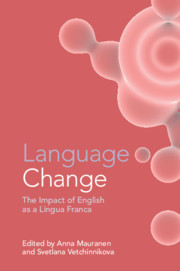Book contents
- Language Change
- Language Change
- Copyright page
- Contents
- Figures
- Tables
- Contributors
- Acknowledgements
- Abbreviations
- Introduction
- Part I Pooling Perspectives
- Part II Zooming in on ELF
- 7 ELF, Language Change, and Social Networks
- 8 ELF and Language Change at the Individual Level
- 9 Are Multilinguals the Better Academic ELF Users?
- 10 The Role of Co-Textual and Contextual Cues for Intelligibility in ELF Interactions
- 11 Exploring the Pragmatics of Computer-Mediated English as a Lingua Franca Communication
- 12 Development of Shared Multilingual Resources in ELF Dyadic Interaction
- 13 The Role of Translanguaging in ELF Advice Sessions for Asylum Seekers
- Index
- References
12 - Development of Shared Multilingual Resources in ELF Dyadic Interaction
A Longitudinal Case Study
from Part II - Zooming in on ELF
Published online by Cambridge University Press: 17 December 2020
- Language Change
- Language Change
- Copyright page
- Contents
- Figures
- Tables
- Contributors
- Acknowledgements
- Abbreviations
- Introduction
- Part I Pooling Perspectives
- Part II Zooming in on ELF
- 7 ELF, Language Change, and Social Networks
- 8 ELF and Language Change at the Individual Level
- 9 Are Multilinguals the Better Academic ELF Users?
- 10 The Role of Co-Textual and Contextual Cues for Intelligibility in ELF Interactions
- 11 Exploring the Pragmatics of Computer-Mediated English as a Lingua Franca Communication
- 12 Development of Shared Multilingual Resources in ELF Dyadic Interaction
- 13 The Role of Translanguaging in ELF Advice Sessions for Asylum Seekers
- Index
- References
Summary
Accumulating studies have shown that ELF interaction can be multilingual, especially through the use of code-switching (e.g. Mauranen 2014, Cogo 2017). Research has also found that ELF-focused interactions can develop into multilingual interactions over time (Kalocsai 2009, Smit 2010). However, studies have yet to examine how such changes occur between two speakers and how the changes can be observed at the discourse level. Longitudinal video recordings of conversations between two participants were analysed using conversation analysis and the framework of epistemics. Detailed analyses of word search sequences demonstrated a gradual change in the speakers’ self-and-other positioning of knowing a code-switched word. The data also displayed emergent use of an interlocutor’s L1 that was not used in earlier recordings. Findings suggest that non-English words can be gradually introduced into ELF interactions over time as speakers learn each other’s L1s, and the development is recognized by the interlocutors.
Keywords
- Type
- Chapter
- Information
- Language ChangeThe Impact of English as a Lingua Franca, pp. 311 - 335Publisher: Cambridge University PressPrint publication year: 2020

